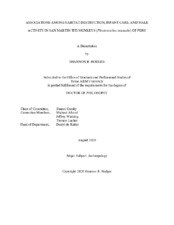| dc.description.abstract | The San Martin titi monkey (Plecturocebus oenanthe) is a Critically Endangered Neotropical
primate endemic to Peru, where forested habitat has been dramatically altered due to
anthropogenic activities. In the face of ongoing habitat destruction, research is urgently needed
on the ability of P. oenanthe to persist in disturbed environments. Prior research has indicated
that titi monkeys are able to adapt behaviorally to disturbed habitats, however such studies have
addressed such flexibility regarding general activities (e.g. traveling) only. This study aimed to
clarify whether level of habitat destruction is related to variation in: 1) infant care; 2) conflict
between caregivers and infants; and 3) male activity budgets. I habituated two P. oenanthe
groups and assigned relative levels of habitat destruction per site by comparing forest fragment
and home range size (and loss per season), logging rate, canopy cover, tree density, tree basal
area, tree height, and fruit availability. Along with two field assistants, I observed study subjects
over two field seasons. We conducted focal follows of four infants using instantaneous sampling
to track: 1) the percentage of care provided by age and sex class, which included male, maternal,
adult (male and maternal care), alloparental (sibling), and total care (all care combined); 2)
caregiver-infant conflict; and 3) the activity budgets of males while caring for infants. I predicted
that level of habitat destruction would reduce infant care (except by siblings), increase caregiverinfant conflict, and lead males to adopt a time-minimizing strategy in response to habitat
destruction. I analyzed infant care and male activity budgets using generalized linear mixed
models. I assessed conflict data qualitatively by comparing average, minimum, and maximum
values. In support of care predictions, greater habitat destruction was associated with reduced
male care and increased alloparental care. Contradicting my prediction, maternal care increased
iii
with habitat destruction. Maternal and alloparental care compensated for reduced male care at the
higher destruction site. As expected, conflict increased with greater habitat destruction and the
male experiencing greater habitat destruction reduced energetically-costly activities. The stark
variation in caregiving, conflict, and male activity across sites indicates a substantial degree of
flexibility in P. oenanthe infant care. | en |


